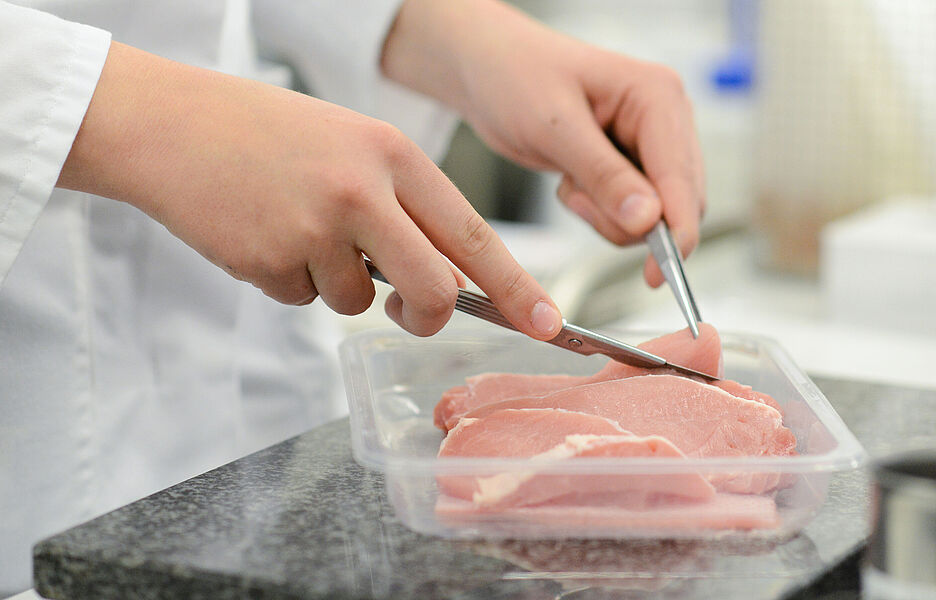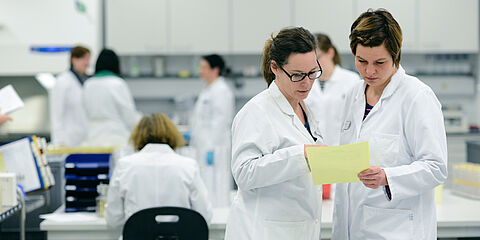What to do in case foreign bodies are detected in food?
Foreign bodies in food are generally defined as physical solids that are not part of the recipe and can be detected by sensory means. Examples are metal parts, wood or glass splinters, textile pieces, hair, plastic particles, cigarette butts, tablets, paint particles, insect and other animal fragments.
Pathways of foreign bodies into food
Foreign bodies can be contained in raw materials due to harvesting, but can also be introduced into food in the course of the further manufacturing process, during storage or during transport. Foreign bodies can also enter the food during preparation. Depending on their nature, foreign bodies can represent a physical hazard. As part of operational foreign object management, possible sources of foreign bodies should be identified and measures taken to prevent foreign bodies from entering food or to effectively remove them from it, for example, by metal detectors, sieves, or bottle inspectors.

Laboratory analysis provides information about identity
The type of foreign body and its origin is not always immediately apparent. In order to obtain further information and to identify or exclude sources, a specific examination of the foreign body should take place in an appropriately equipped laboratory.
Initial indications are provided by a visual inspection, which in most cases allows a rough classification of the material, such as glass, metal, wood, plastic, or textile. Furthermore, a photographic documentation and a documentation of the dimensions should be made. Special attention should be paid to sharp edges or points, as this is relevant for the later assessment of a physical hazard. Adhesions or distinctive deformations can provide valuable information about the origin and history of the foreign body.
Detection of plastic, biological or powdery foreign bodies
In the case of biological materials, a light microscopic examination can provide further information about the identity of the foreign body. In the case of powdery foreign bodies, amorphous or crystalline structures can be detected in this way. Plastics, such as films or hard plastic particles, can be examined more closely in a non-destructive manner using Fourier transform infrared spectroscopy (FT-IR spectroscopy). In the ATR technique (“attenuated total reflection”), the foreign body is mechanically fixed over a diamond light guide. The reflection spectra obtained can be evaluated electronically using a spectra library. They allow conclusions to be drawn about the type of polymer and additives, such as plasticisers. For inhomogeneous materials, it must be taken into account that the ATR technique only provides information about the composition of the surface.

Identification of glass, metallic or mineral foreign bodies
Energy dispersive X-ray spectroscopy (EDX) can be used to identify glass or other predominantly inorganic particles. For this purpose, the sample is fixed on a sample carrier and, if necessary, vapour-plated with gold. In a scanning electron microscope, the elements contained are excited by an electron beam at the energy characteristic for them. They can thus be identified by the position of their energy line in the spectrum. The strength of the signal allows conclusions to be drawn about the content of an element in the sample. In this way, elements from atomic number 6 (carbon) can be identified, a semi-quantitative evaluation is possible from atomic number 11 (sodium). Based on their characteristic elemental composition, it is thus possible to distinguish between different types of glass (bottle glass, laboratory glass, flat glass, etc.). This technique is also very suitable for identifying metallic or mineral foreign bodies.
One advantage of EDX is that the procedure can be carried out spatially resolved. Even with relatively small inhomogeneously composed foreign body particles, specific sub-areas can be examined in this way. In addition, it is possible to take scanning electron micrographs that provide further information about the microstructure of a foreign body.
Other powerful methods for investigating elemental composition are X-ray fluorescence analysis (XRF) or inductively coupled plasma mass spectrometry (ICP-MS).

Molecular biological examination of foreign bodies in food
In the case of plant or animal fragments, such as bones, a molecular biological analysis is recommended to obtain information on the identity of the foreign body. This can be done via a species-specific polymerase chain reaction (PCR) or with the help of a PCR-RFLP (restriction fragment length polymorphism).
The experts at WESSLING support you in the identification and evaluation of foreign bodies in food. Thanks to our professional know-how and our state-of-the-art technical equipment, we offer our customers the complete range of the aforementioned examination methods.
Should the results of your food samples ever show deviations in safety, our competent contact persons are at your disposal. They have many years of experience in dealing with such situations and will advise you in a neutral and independent manner so you can act as quickly as possible.
Your contact to our food experts
- Christina Witt
- +49 2505 89-633
- food@wessling.de

„The market success of food depends significantly on its quality and safety. That's why we support the identification and evaluation of foreign bodies in food and provide neutral and independent advice.“



